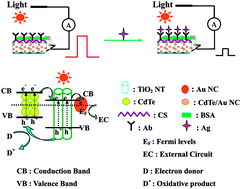In this paper, tris(2,3-dibromopropyl) isocyanurate (TBC) is for the first time as far as we know determined by ultrasensitive photoelectrochemical (PEC) immunoassay using an antibody-modified ternary hybrid CdTe/Au–TiO2 nanotube arrays (NTAs) photoelectrode, developed by the pulse electrodeposition technique. The as-prepared hybrid shows enhanced photon absorption and photocurrent response, which subsequently increased the photoelectrical conversion efficiency in the visible region. TBC-antibody (Ab) was developed in rabbits as a result of immunization with the BSA–TBC conjugate and covalently cross-linked onto the CdTe/Au–TiO2 NTAs. Since the photocurrent is highly dependent on the TiO2 surface properties, the specific interaction between TBC and the antibody results in a sensitive change in the photocurrent, which displayed a linear range of 5.0 × 10−11 to 5.0 × 10−5 M and a low detection limit of 5.0 × 10−11 M for TBC determination. This proposed strategy highlights the application of TiO2 nanotube in visible-light-activated photoelectrochemical biosensing, which could largely reduce the destructive effect of UV light on biomolecules.

You have access to this article
 Please wait while we load your content...
Something went wrong. Try again?
Please wait while we load your content...
Something went wrong. Try again?


 Please wait while we load your content...
Please wait while we load your content...